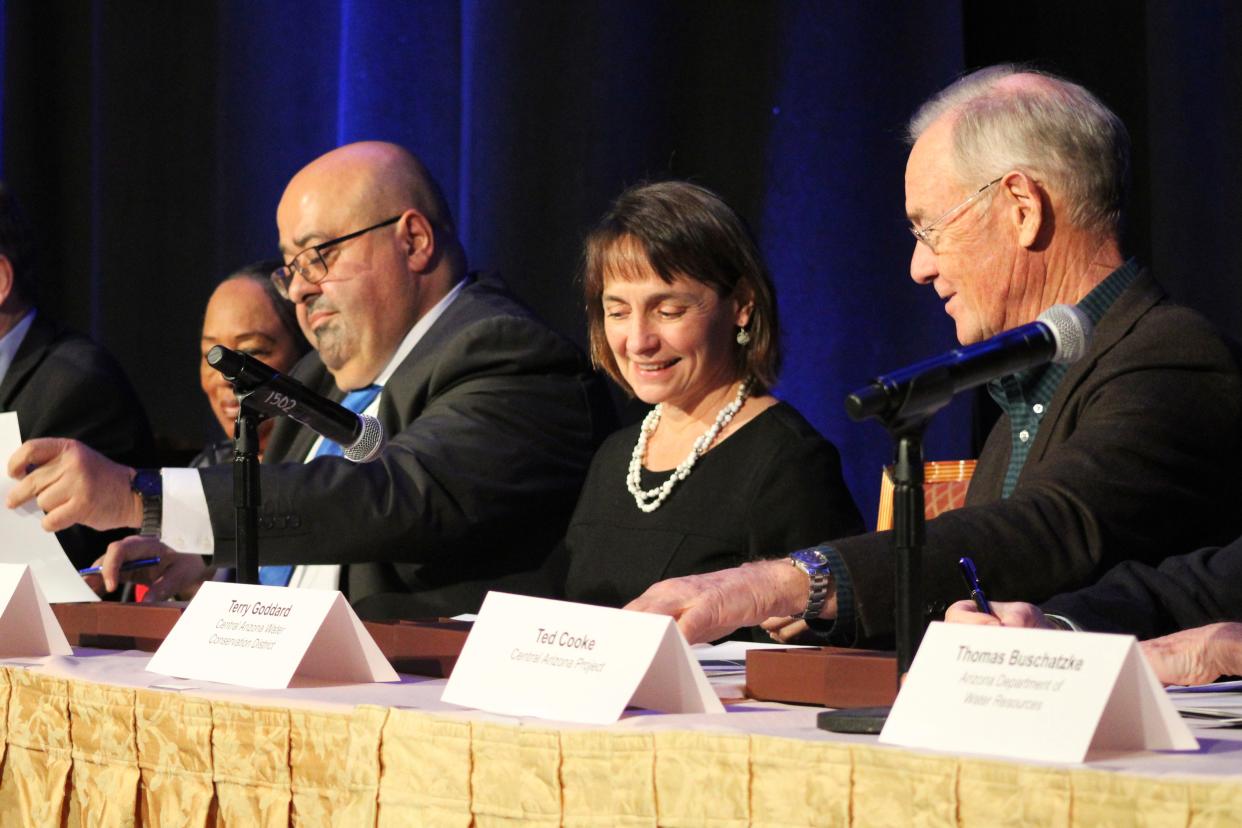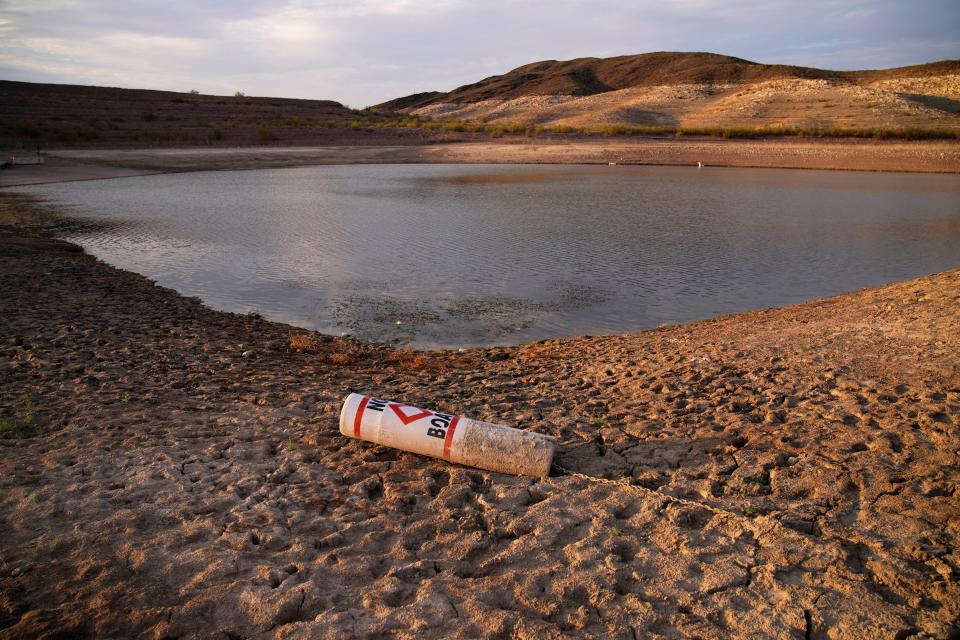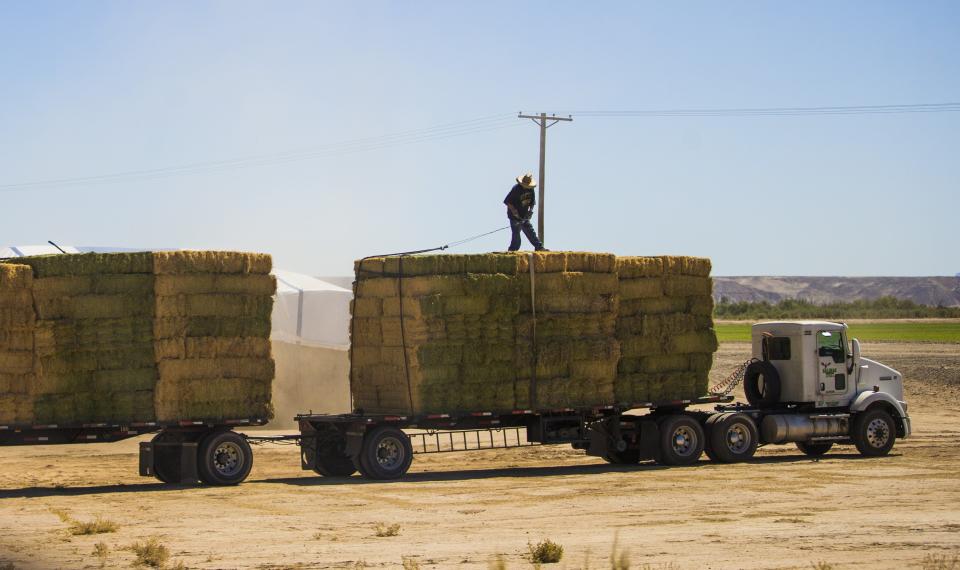Arizona joins Nevada, California and tribes in a pledge to slash Colorado River water use

LAS VEGAS — Arizona on Wednesday agreed to join neighboring states, tribal communities and the federal government to dramatically reduce the amount of Colorado River water drawn from drought-stricken Lake Mead for the next two years.
The top water managers for the state and the Central Arizona Project joined their counterparts from southern Nevada and California and the U.S. Interior Department in signing a commitment to slash 500,000 acre-feet a year. It's enough to support more than a million Southwestern households, though most of the cuts will affect farm users who are willing to be compensated.
They’ll do it with $200 million in funding that will be used to pay users to leave water in the reservoir over the next two years, with half the money coming from the federal government through the recently passed infrastructure funding law.
Among the key players in the agreement are tribal water users in Arizona, who have already agreed to contribute at least 180,000 acre-feet of water toward the goal.
At a Caesars Palace signing during the Colorado River Water Users Association’s annual meeting, the partners from across the Southwest pledged to keep working together to find long-term solutions for coping with a fast-declining river.
“We’re not going to abandon the Colorado River,” said Adel Hagekhalil, general manager of the Metropolitan Water District of Southern California. “We’re not going to turn our backs to it. We’re not going to turn against each other.”
Living with what rain and snow deliver to the river is fast becoming more challenging. The reservoirs that store water from Wyoming and Colorado to Arizona and California were near capacity when drought began in 2000, but now are just 37% full in combination.

Warming temperatures have shrunk river flows even in years when precipitation in the huge river basin was near normal. Last year’s snowpack was about nine-tenths of the long-term average, but the runoff reaching Lake Powell, from where it’s delivered to the three lower basin states and Mexico, was just one-third of normal after evaporation, dry soils and thirsty forests and rangelands took their fill.
Colorado State University climate scientist Brad Udall warned that the long-term outlook is for more of the same or worse. A recent study pegged a loss of river flow at 9% per degree Celsius of warming, he said, and at least that much new warming is projected by mid-century. He asked managers to stop calling the West’s unfolding crisis a drought, and instead call it "aridification." It will take more deals like the one signed Wednesday for the region to protect its river, he said.
“It’s going to take everybody in this room pulling forward,” Udall said.
Tribes will contribute to deal
The partners have not yet announced who will forgo all of the water they envision saving over the next two years, though the Gila River Indian Community confirmed that it’s in for saving likely the biggest share: 129,000 acre-feet a year.
“This demonstrates the vital role that tribes are playing,” Gila River Indian Community Gov. Stephen R. Lewis said.
The Colorado River Indian Tribes agreed to add 50,000 acre-feet to the effort by fallowing fields.
“The Colorado River has sustained us for many, many generations,” Chairwoman Amelia Flores said. “We continue to live and walk along the banks of the Colorado River. It is time for all of us to help save this river.”
The parties have identified willing participants accounting for the rest of the water to be saved in 2021 and most of that envisioned for 2022, said Tom Buschatzke, director of the Arizona Department of Water Resources. But they don’t want to announce them before participating irrigation districts and others have a chance to formally accept the terms.
The states have discussed this deal since around the time the Interior Department released troubling new projections for continued reservoir depletion in August. The two-year deal is intended to be a down payment on five years’ worth of reductions as a bridge to a larger required renegotiation of dam operations by the Bureau of Reclamation in 2026.
“We are at a sobering time,” Southern Nevada Water Authority General Manager John Entsminger told fellow water managers from across the river system. He noted that the river’s storage — mostly Lake Mead and Lake Powell — had lost 7.7 million acre-feet since the group last met in person two years ago, before going virtual during the pandemic last year.

“More action is needed, and more action is needed now,” he said.
His agency, which serves mostly urban water users in the Las Vegas area, already is known for subsidizing grass removal and enforcing watering restrictions, and is poised to take aggressive action to further curb use.
SNWA officials say they’ll ask their board next week to ban new grass lawns except at schools and parks; restrict pool sizes; place a moratorium on evaporative cooling systems; cut the district’s per-capita water use from 112 gallons today to 86 gallons by 2035; and reduce golf course irrigation from six acre-feet per acre each year to four.
The district even proposes to ban new golf courses.
“It’s a very large consumptive use, and it’s no longer appropriate in this desert community,” said Colby Pellegrino, the Las Vegas district’s deputy general manager.
Drought: With cutbacks imminent, states scramble to save Colorado River water

Farmers will shoulder the first cuts
Arizona’s actions are focused on paying water users to voluntarily leave water in Lake Mead over the next couple of years, with negotiations continuing to secure more savings through 2026.
The state Department of Water Resources will spend $40 million over the first two years, and the Central Arizona Project, which delivers the water that’s subject to cuts, will spend $20 million. In California, the Metropolitan Water District will spend $20 million. In Nevada, SNWA will spend $20 million. At the federal level, the U.S. Bureau of Reclamation is committing $100 million.
“We stand ready to be a full partner with those who want to work with us,” Reclamation Commissioner Camille Touton told the group via a remote video address from Washington.
The new infrastructure funding law includes more than $8 billion for drought projects and grants, $2.5 billion for settling tribal water rights and $300 million specifically for drought contingency projects in the Colorado River basin. “We’ll have the resources to back up that commitment,” she said.
The newly accepted cuts are layered atop a 2019 Lower Basin Drought Contingency Plan in which Arizona agreed to leave 192,000 acre-feet of its share of Colorado River water in Lake Mead even before any official shortage declaration, in hopes of preventing worse losses.
That plan also called for deeper cuts in any year in which the federal government projected that Lake Mead would start out below 1,075 feet in elevation. That declaration is now in effect for 2021. It means that in addition to the new agreement’s terms, Arizona will give up 512,000 acre-feet, 18% of its river share, in the coming year.
Nevada, which starts with a share of just 300,000 acre-feet, will give up 21,000 next year. California, with higher-priority river rights, does not face involuntary cuts until deeper shortages kick in.
'Do one thing'
The unrelenting 20-year drought and the resulting plunge in Lake Mead’s levels caused the states to redouble their efforts for fear that the reservoir could soon drop below 1,025 feet above sea level. If it does, Arizona would have to forgo 720,000 acre-feet. Nevada would also give up more of its smaller share, and California would lose 350,000 acre-feet.
In Arizona, the cuts fall hardest on farmers who use water pumped through the Central Arizona Project canal past Phoenix to Pinal County. Those users plan to fallow much of their land next year, and are also using state money to drill new wells to tap groundwater.
Arizona cities have the water supplies they need, so residents won’t suffer losses under the cutbacks coming in the new year. With less water flowing across the desert in a canal system that still needs to be paid off, though, residents might face rate hikes in the near future.
In response to a reporter’s question about what Southwesterners can do to help, Metropolitan’s Hagekhalil said all 40 million people who use the river have a role in its conservation, from reducing shower times to fixing leaky pipes or planting water-saving yards.
“Every drop we can save is a drop we can store for the future,” he said. “Today is a call for everyone: Do one thing for our water future.”
Brandon Loomis covers environmental and climate issues for The Arizona Republic and azcentral.com. Reach him at brandon.loomis@arizonarepublic.com.
Environmental coverage on azcentral.com and in The Arizona Republic is supported by a grant from the Nina Mason Pulliam Charitable Trust. Follow The Republic environmental reporting team at environment.azcentral.com and @azcenvironment on Facebook, Twitter and Instagram.
This article originally appeared on Arizona Republic: Facing mandatory cutbacks, Arizona will pay users to save more

